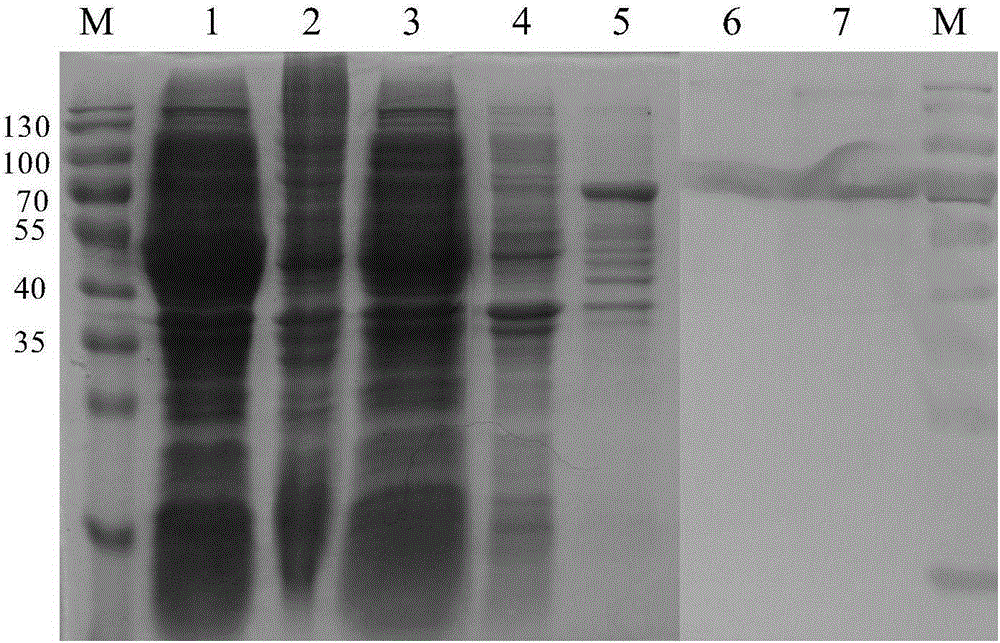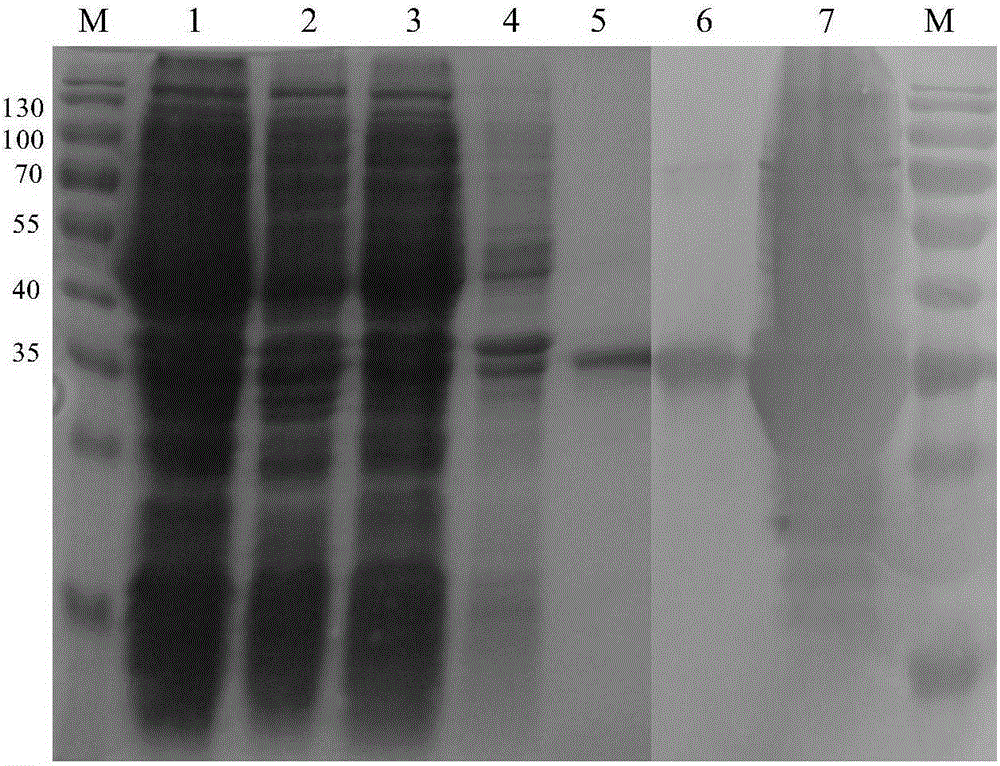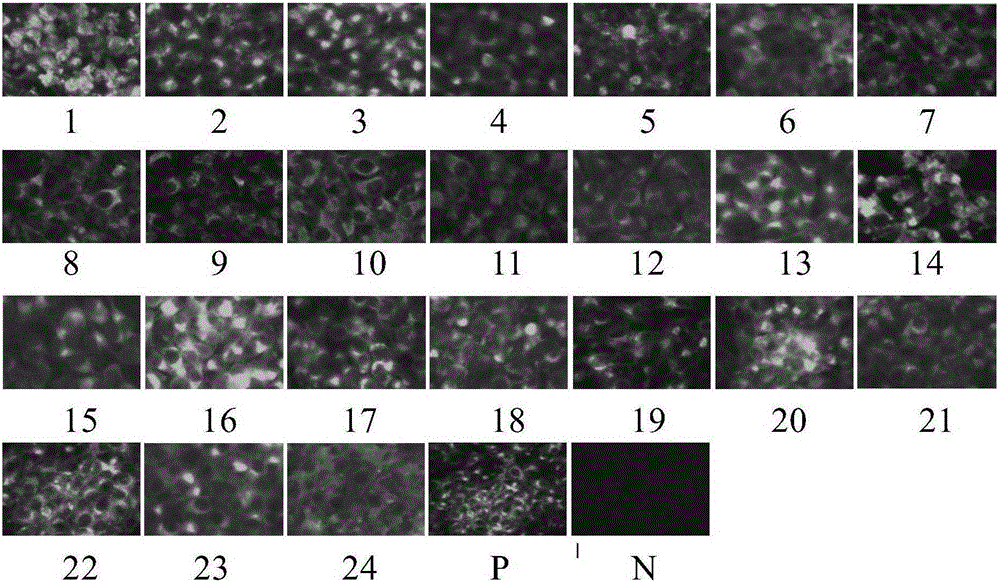Monoclonal antibody BTV (Bluetongue virus)-NS3-3D8 of anti-BTV NS3 protein, B cell epitope identified by monoclonal antibody and application
A bluetongue virus and monoclonal antibody technology, applied in the direction of antiviral immunoglobulin, antiviral agent, antibody, etc., can solve the problems that the biological function has not yet been determined, and the structure and function of NS3 protein are not clear.
- Summary
- Abstract
- Description
- Claims
- Application Information
AI Technical Summary
Problems solved by technology
Method used
Image
Examples
Embodiment 1B
[0032] Prokaryotic expression and purification of embodiment 1BTV15NS3 protein
[0033] 1. Primer Design
[0034] PCR amplification primers were designed according to the known BTV15 type S10 gene sequence (GenBank accession number: AGJ83560.1), and restriction sites EcoRI and HindIII were respectively introduced into the 5' ends of the upstream and downstream primers, and the prokaryotic expression vectors were PET -30a and pMAL-C4X:
[0035] B15-PET-NS3-F:5'-CCgaattcATGCTATCCGGGCTGATCC-3'
[0036] (EcoRI)
[0037] B15-PET-NS3-R:5'-GCaagcttTCAGGTTAATGGCATTTCGA-3'
[0038] (HindIII)
[0039] B15-pC4X-NS3-F:5'-CCgaattcATGCTATCCGGGCTGATCC-3'
[0040] (EcoRI)
[0041] B15-pC4X-NS3-R:5'-GCaagcttTCAGGTTAATGGCATTTCGA-3'
[0042] (HindIII)
[0043] 2. Construction, expression and purification of BTV15NS3 protein prokaryotic expression vector
[0044] The plasmid pEASY-NS3 already in the laboratory was amplified by PCR to obtain the S10 gene and recovered from the gel, and th...
Embodiment 2
[0046] The preparation of implementation example 2 monoclonal antibody
[0047] 1. Immunization of Mice
[0048] Five 6-week-old BALB / c female mice were immunized with the recombinant BTV15-NS3 protein expressed by the gel-cut purified prokaryotic expression vector PET-30a as an immunogen by intraperitoneal and subcutaneous multipoint injection, 100 μg / mouse. A total of two immunizations. Since no adjuvant was used in the immunization process, the handle of a 20ml syringe was used to crush the SDS-PAGE gel strip containing BTV15-NS3 protein each time the immunogen was prepared, and an appropriate amount of PBS buffer was added, and the freeze-thaw was repeated 3 times. Until the rubber strips are completely broken into a soft porridge. The immunization procedure is as follows: the interval between the first immunization and the second immunization is 14 days, the blood is collected by docking the tail one week after the second immunization, and the serum antibody titer of th...
Embodiment 3
[0077] Example 3 Identification of Monoclonal Antibody Characteristics
[0078] 1. Identification of Monoclonal Antibody Subclasses
[0079] Follow SBA Clonotyping TM System / HRP Antibody Subclass Identification Kit Operating Instructions The monoclonal antibody obtained in Example 2 was used for subclass identification.
[0080] Its identification result shows that monoclonal antibody BTV-NS3-3D8 of the present invention is IgG 1 type.
[0081] 2. Indirect Immunofluorescence Assay (IFA)
[0082] (1) Plate the BHK cells in good growth state on a 96-well cell plate. When the cells grow to 80-90% of the bottom area of the plate, inoculate BTV1-24 viruses with DMEM basal medium; at the same time, do not inoculate under the same conditions Viral BHK cells served as a negative control.
[0083] (2) After about 24 to 36 hours, when the cells have not undergone obvious lesions, discard the culture medium, add -20°C pre-cooled 75% ethanol in an amount of 100 μL / well, and fix at ...
PUM
 Login to View More
Login to View More Abstract
Description
Claims
Application Information
 Login to View More
Login to View More - R&D
- Intellectual Property
- Life Sciences
- Materials
- Tech Scout
- Unparalleled Data Quality
- Higher Quality Content
- 60% Fewer Hallucinations
Browse by: Latest US Patents, China's latest patents, Technical Efficacy Thesaurus, Application Domain, Technology Topic, Popular Technical Reports.
© 2025 PatSnap. All rights reserved.Legal|Privacy policy|Modern Slavery Act Transparency Statement|Sitemap|About US| Contact US: help@patsnap.com



